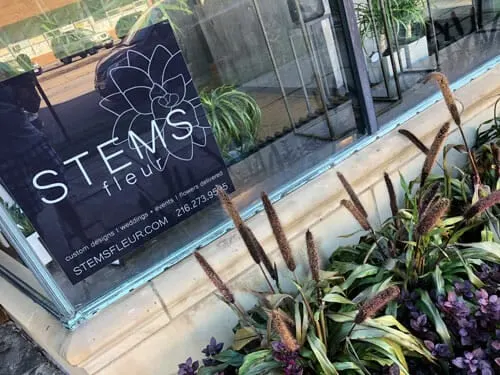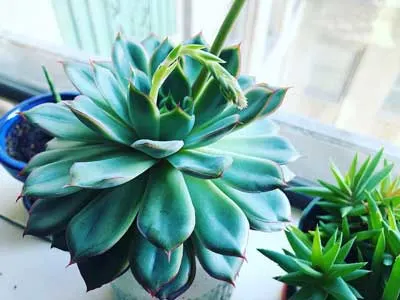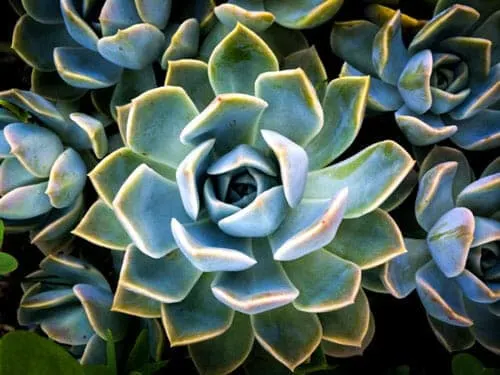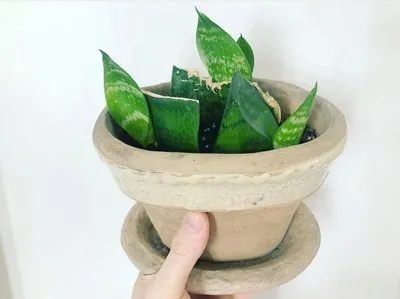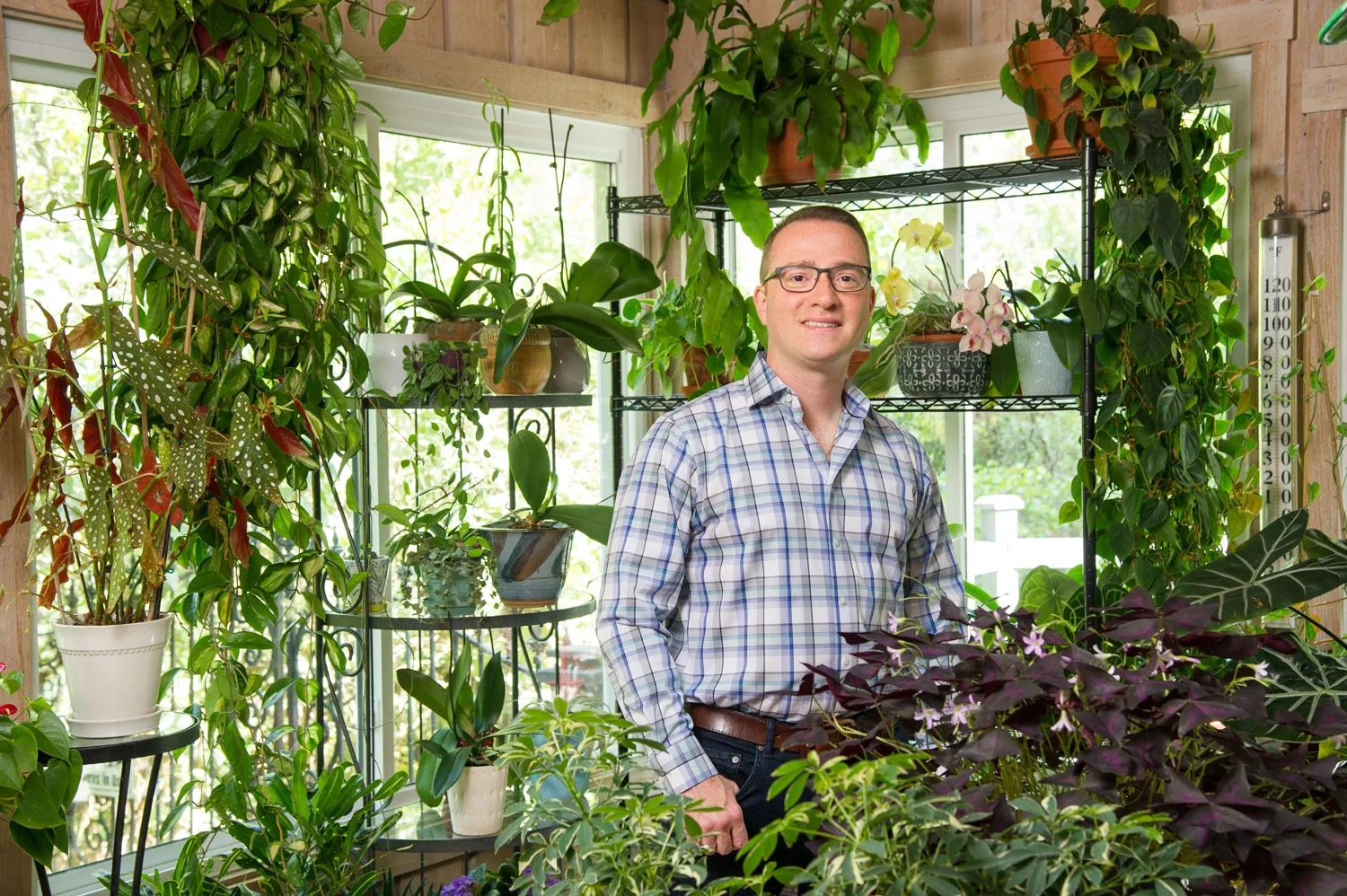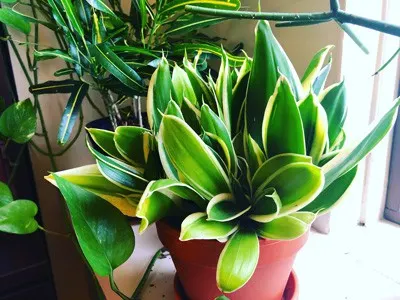Some of the links in this post may be affiliate links.
I recently interviewed Scott Robertson, owner of Cleveland Heights florist Stems Fleur, and featured a blog post on Stems Fleur. We also talked about propagating Echeveria, and many other types of similar succulents, so I made a separate blog post on this topic.
Towards the end of the interview, after having a wonderful and detailed conversation on succulent propagation, we also touched on air plants.

Leaf Propagation of Echeveria and Other Succulents
Raffaele: I don’t know about now, but you used to propagate a lot of succulents. Do you still do that?
Scott: I still do that!
Raffaele: Are you growing material to use for your designs, or for fun?
Scott: I grow for both. Because a lot of our designs have succulents heads that we clip off that we use for arrangements for the texture and the look of it. I’ve even taught people how to root those.
Once they take them home, they can take them out of their arrangements. So that it is an arrangement that keeps on giving!
Last winter in my studio I put some grow lights on some shelves and I took all the petals off of the succulents, and I laid them in Miracle Gro Moisture Control Potting mix in plastic flats.
In the smaller trays that are plug size. So I would lay all the leaves in rows. I keep them misted. By the end of the winter I have full succulents that I put into pots and let them grow bigger.
So this past year I put in probably 20 of them into two terra cotta pots at home and they’re beautiful and full. Now I can redo the process again.
Raffaele: Then you can use those for your designs, and whatever you’re doing at the time.
Scott: Yeah, and I just love growing them. It’s fun to watch those little baby hairs grow and turn into a plant!
Raffaele: What kind of grow light? Is it a certain kind of grow light that you use?
Scott: The ones I use are the LED grow lights. Tube light. And they seem to do great and are better on electricity.
Raffaele: Sure, LED lights are definitely energy efficient!

Scott: Yep, and we put them on a timer. Keep them on for 8 hours a day. It probably could be longer but it seems to be enough.
Raffaele: Sure, it’s sufficient, and things are growing well?
Scott: Yep.
Raffaele: And then you said you use just the potting mix, and once you separate the leaves or the petals, you just place them on top of the soil in the plugs?
Scott: Yes, just lay it right on top, and if you leave just a little bit of the soil level down into the plugs, it allows the leaf petal to be upright more on a little angle.
Raffaele: So that they’re a little bit angled down so that where the leaf snapped off of the plant, that part is in contact with the soil?
Scott: Yes. That’ll just be touching the soil. Some people will start them out growing in open air and the roots start growing out. But if you do it my way, the roots start growing right into the soil.
Raffaele: Then you don’t have to actually pot them because they are actually starting to grow.
Scott: And then from there, once that little plug is full of roots, you can actually pull them out and put them into bigger pots.
I’ve been lucky to go to propagation greenhouses and see how they do that too, and see how they go from a plug to a bigger pot, to another bigger pot. The whole process!
Raffaele: Oh wow, so that’s how they propagate succulents!
Scott: Yes, for a lot of them.
Raffaele: How often do you mist them?
Scott: When they’re babies like that, I like to keep the soil moist as much as possible. That really encourages the root growth.
But you don’t want the leaf to be under the soil because it’ll rot. You just want it to be laying on it.
Raffaele: Just touching. So just contacting the soil, but not buried?
Scott: Right. Once those roots see that there is moisture in the soil, they’ll just start going crazy. And some people think, oh you don’t want too much water!
But I find that if the soil stays moist…once they start growing I mist them maybe twice a week. And in the mister you can put some plant food. Very weak plant food, and it will also strengthen the roots and the new baby plant.
Raffaele: What kind of succulents have you propagated?
Scott: Well I don’t know all the names of them, but I’ve found that there are different varieties that do propagate quicker and easier.
But whatever I have, I just start propagating because it’s fun! Actually I have one that I want to give you too! Yesterday a deer came by and chopped off one of them in my yard!
Raffaele: Hahahaha. So when you snap the leaves off, do you let them dry first to let them callous over?
Scott: Yes, you’re supposed to do that.
Raffaele: So do you normally do that? Do you let them air dry somewhere before you place them on top of your moist potting medium?
Scott: Yes that’s right. You don’t want to put them directly on the potting mix right away. You want them to callous over, because that’s also what triggers the roots.
Raffaele: How long do you typically let them dry?
Scott: Some people say 24 hours, but you can even let them dry for a week. They’ll be fine.
Raffaele: And then once you have that, you put your potting mix in the little plugs in the flat tray, and do you water it first and then put the leaves on top?
Scott: I water the soil first, and put all the leaves on, and then I try to keep the soil as moist as possible from there.
Some of the seed starter trays have another tray underneath them, so you can put some water in that tray and the water will soak up. You don’t want to do that once they start growing though!
But it’s a good way to trigger the roots. They’ll know the moisture is there. They’ve got feelers out! Hahaha.
Raffaele: So once they start growing the roots, then you can back off on the watering and then let them dry out a little bit before watering again.
Scott: Yes, but you get the best growth for the roots if the soil stays evenly moist until it starts to get the little babies growing.
Raffaele: And that’s very contrary to what a lot of people think about succulents because they think “oh they don’t need much water!”
A lot of people send me, all the time, issues with their plants on my Instagram (@ohiotropics). I ask them to send me pictures, and they’re all dried up and a little sad. I then ask them how they water them.
And they tell me that they drip a little bit of water every few weeks. And I tell them, no you need to soak the hell out of them when you water them and let them dry in between!
What would you recommend to your clients or customers that come in and buy a potted succulent? You have this beautiful jade plant here and all these succulents. How do you recommend that they water those plants.
Scott: Well some of these that we sell are in ceramic containers so there is no drainage. So I always have a little tip and I don’t know if you noticed this.
If the soil on your plant is moist, it will feel cool when you touch it. If it’s not cool, it’s almost dried out.
Something that is in a ceramic container, as you know, you want to make sure that you don’t do so much water that it can’t drain out and it rots on the bottom.
Sometimes you can take the whole plant out and water it. I always water with warm water because it soaks in better and faster.
Sometimes if you water with cold, it’ll kind of go over the soil and it’ll go to the bottom and you don’t think you watered enough. But warm water will absorb faster.
I tell them to turn 15 minutes (90 degrees) on a clock every week so that it gets even growth. So that’s a good tip to keep spinning your plants for even growth.
Succulents need very sunny windows to thrive in. So I always tell people to use a south or west facing window because they really like evening, beating sun a lot.
Some are a little more tender and need a little more shade cover, but I would just do your research.
The ones that I have here love the sun. I have an Agave and the more it bakes the better because it’s used to that in its natural environment.
But you can even see how I’ve displayed them here, all the cacti and succulents are right by the window, and all the things that need less light are further back.
And so we get this beam of sun at night that hits the Sansevieria centerpiece over there and it hits it perfectly so it has got to be right there! I’m always moving stuff. These all seem to like the reflective sun [built in living wall with plants behind the front desk].
Raffaele: You definitely have great light in here!
Scott: It’s reflecting off of the windows across the street. The sun is rising and hitting the windows and reflecting back in here.
Raffaele: Oh! That’s perfect! Hahaha. I was going to say it’s pretty bright for this time of day for a Western window in the morning. But that’s true, I see all the silver panels across the street reflecting the light.
Scott: It’s almost too much. At the end of the day it gets very hot in here, so we might do an awning up there because it feels like you’re in a tanning bed!
Raffaele: I also noticed that you have some air plants that you sell. Can you tell me a little bit more about the varieties and how you recommend taking care of them to your customers.
Scott: Air plants as you know can be a little finicky, but they can also do really well if you find their sweet spot.
I decorated a rabbi’s apartment in New York City and I put in a big piece of cork right off the tree in one of her window sills. And she got like a northeast kind of light.
And I put one of the xerographicas just resting on the cork, and I forgot to tell her how to take care of it, and I came back two years later and it was huge!
And she told me “I never do anything to it! I haven’t even moved it or dusted it. So she had the sweet spot. Because I think she had humidity coming from the heater…like the radiator.
Raffaele: Did she mist them?
Scott: She didn’t do anything! It was some freak of nature thing but she had the sweet spot.
Raffaele: That’s interesting, wow! It must have been really humid because otherwise they would just dry up and die.
Scott: Yeah. And she had some other ones. I gave her a ZZ plant. And I told her to maybe water that one once a month. She watered that one a little too much so that one started to rot, so we got her a replacement.
For most airplants, I tell people to give them bright indirect light. Full sun will fry them out as you know, because in their natural habitat they grow in trees in the jungle, in the tropics.
And they like the shade and humidity. They don’t need soil because they do start to grow roots. Some can just be misted maybe once or twice a week, depending on how dry it is.
The xerographica can be soaked like you show people on your blog. I found that my main mistake is where I’ve soaked it but haven’t drained all the water off and they’ve rotted.
Because the water will sit in the creases and rot them. Also if you water them too much, even the smaller ones will rot as well.

Raffaele: I normally soak them and then I’ll literally grab them at the base and shake them to get the water out. And sometimes I’ll also let them dry upside down so everything drips out.
Scott: Yeah. At one time I put one in a glass terrarium with moss in there and we were going on vacation so I put water on the moss so it would stay humid while we were gone, and we came back and it was all rotted out.
It was resting in water.
Raffaele: They need the drainage. No standing water for sure. So tell me where people can find you online, social media?
Scott: So our new store is at 2495 Lee Boulevard in Cleveland Heights, and make sure it’s Boulevard and not Road otherwise you will end up at someone’s house!
Raffaele: And that’s what happened to me this morning! Hahaha!
Scott: The first flower delivery that we had here in the new space, the wholesaler dropped them off on the porch of that house.
And we had to go find them! So I tell everybody, make sure it’s Boulevard! And we are in the iconic and historic Rockefeller building. It was built by the Rockefeller family and it’s absolutely beautiful. It looks like you are in Europe.
We have lots of businesses and creative stores in this building and it’s a really nice place to visit. We are open Monday through Friday 10am-6pm. Most Saturdays unless we have an event or party. I would call ahead of time on Saturdays.
Raffaele: And on the internet?
Scott: www.stemsfleur.com and we are also stems_fleur on Instagram and we are also on Facebook as well. On the website too, people can look under services and see different things and photographs of what we do.
We are still working on that. But that’s also where people can order flowers direct. You can set up an account and easily order, or call the shop and order.
The plants and giftware in the shop always changes so it’s nice to stop in and see what’s new and fresh.
I hope you’ve learned a lot about succulent propagation. And if you’ve never done so, give it a try! It’s fun and very rewarding!


